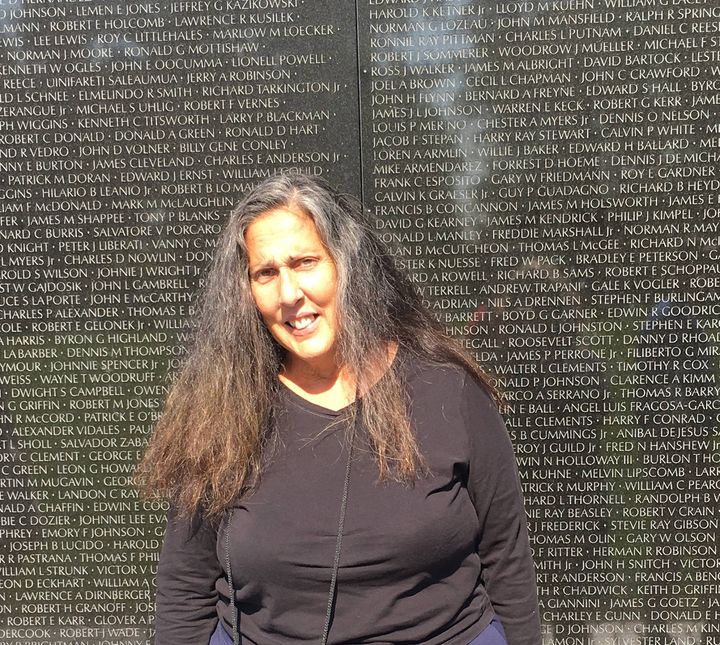
When she thinks about the time she spent in the parking lot, Mary Ann Vecchio’s thoughts shift back and forth between watching Allison Krause last attempts to speak and the massive hole torn through the back of Jeff Miller’s head. “I was shocked by all the blood. There was just so much blood,” Vecchio explained in the car on her way to Washington D.C. Wednesday, to voice her qualified support of a Kent State National Monument. Vecchio continued, “It was a sit down. The soldiers were lined up and yeah, they had tear gas, but we never expected that they’d shoot at us. Then they started coming at us with the guns with bayonets, in full riot gear, wearing gas masks. And I was scared to death.” After 46 years, Mary Ann still cries when she details the events of May 4, 1970, the fateful day that the Ohio National Guard opened fire on unarmed protestors at Kent State University.
There were lots of kids at Kent that day. Four killed. Nine wounded. And hundreds more hit the ground when the bullets started flying, but only one was immortalized in a Pulitzer prize winning photograph that graced front pages from Cleveland’s The Plain Dealer to Newsweek magazine. John Filo, a photojournalism major in the crowd that day, opened his shutter and captured the horror and anguish of everyone on that campus. Vecchio’s picture remains one of the most impactful photos of the 20th century.
Consequently, modern memory would remake Mary Ann Vecchio as the face of the Kent State Massacre.
Sadly, at the time, Vecchio and the fallen protesters became the poster children for the Nixon Administration’s assault on the character of student protestors across the nation. Nixon himself called the students, “bums.” Back in her home state of Florida, the governor, Claude Kirk, called Vecchio a communist. Vecchio, not a Kent student, was a teen who had run away from home to protest the war in Vietnam. Kirk used her non-student status to character assassinate Vecchio. He said that she had been planted at the University by the communists and that she was responsible for the deaths of the students there. The press hounded her. The FBI hunted her. Local police profiled her. And she has yet to forgive herself for the pain she caused her parents.
By 1990, even though popular sentiment had begun turning in favor of the student protesters, Vecchio had slipped into hiding. She’d stopped granting interviews except to ask reporters and their news agencies to leave her alone. She’d explain that Kent State had ruined her life. She didn’t trust the media – several of whom had turned her over to the FBI after she’d agreed to meet with them in the early 70’s. She was so heavily targeted that she couldn’t speak out against the injustice she’d witnessed. Vecchio wanted nothing to do with the fame and shame her time at Kent State brought her.
Until this week.
Mary Ann Vecchio ventured out to address the National Park System Advisory Board about the possible designation of the Kent State Shootings Site as a National Monument.
The campus at Kent State is owned by the state of Ohio. The parking lot where Jeffrey Miller, Allison Krause, William Schroeder, and Sandra Scheuer were killed is effectively public property. Creating a National Monument on the site should be pretty straightforward. Laura L. Davis, Professor Emeritus of English – herself, a student protester that day – and Mark F. Seeman, Professor Emeritus of Anthropology authored the application. In their submission they credit current faculty with assisting them in their collection of data for the application. They don’t however cite victims like Mary Ann Vecchio as contributors to the request, because Vecchio and others were omitted from the process.
Vecchio explained her feelings to the board, “Like so many of us present at the Kent State shootings, I have carried profound life-long consequences for my presence at the massacre site… Kent State University does not own the narrative of what took place on May 4, 1970. It belongs to each of us there that day, those injured whose lives were forever altered, and above all to the families of those killed.”
Fortunately, the National Park System Advisory Board rectified the applicants’ blunder. The board agreed unanimously that the Kent State site fit the criteria of historical significance but after lengthy discussion they also agreed that many appropriate accounts were missing from the story. The board charged Davis and Seeman with amending their applications to include the appropriate historiography associated with Kent State. The board reminded the applicants that this controversial event demanded the inclusion of different perspectives and – more importantly – that those perspectives be respected.
There were reasons the protestors were killed at Kent State and all the evidence and every principle – especially the memories of the victims – must be included when available. The greatest gift any historian can receive is an eye witnesses to an event as well as the consequences that shaped the policies that followed.
The board concluded, due to the complexity of the controversy over the excessive force used on protesting American citizens, the nomination is incomplete without the involvement of people like Mary Ann Vecchio. For the first time in Vecchio’s life, she feels like she was heard by agents of the government: a government that – until now – had only failed her.